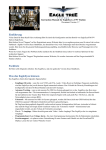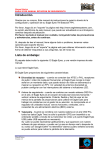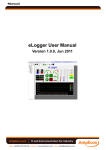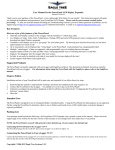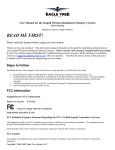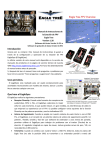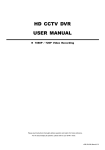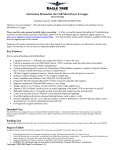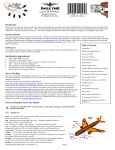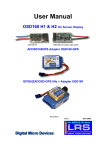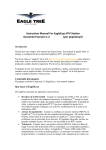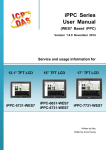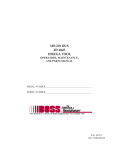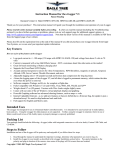Download Instruction Manual for the Flight Data Recorder
Transcript
Instruction Manual for EagleEyesTM FPV Station Document Version 1.21 (Vector Software Version 11.78+, or Data Recorder Software Version 10.39+) Introduction Thank you for your purchase! This instruction manual will guide you through the configuration and operation of your EagleEyesTM FPV Station (the EagleEyes). The latest version of this manual is available in the Product Manuals section of the Support tab on http://www.eagletreesystems.com. Please read the entire manual carefully before proceeding. If, after you read the manual, you have further questions or problems, please see the “Have Questions or Feedback?” section below. Intended Uses The EagleEyes is intended to be used exclusively for recreational purposes with model planes, boats and cars. Any other use is not supported. What the EagleEyes Does The EagleEyes provides all of the following features: Receiver Diversity - when you connect two NTSC or PAL audio/video receivers (of any frequency), the EagleEyes picks the better signal at any given time, which can greatly reduce video fades and improve your FPV experience. A variety of diversity settings are configurable with the on-board switches and LED indicators. Antenna Tracking - when coupled with our Vector or OSD Pro airborne system, the EagleEyes is the heart of a full-featured pan/tilt antenna tracker. Powerful, flexible, and easy to use PC software and onscreen menus are provided for calibrating the EagleEyes to work flawlessly with the tracker of your choice. The built-in regulator drives even large pan/tilt servos, with no need for an external BEC. Telemetry - When coupled with our Vector or OSD Pro airborne system, all Eagle Tree data (not just GPS position) are transmitted to your laptop, via your video transmitter and the EagleEyes USB port (separate USB cable required). Your flight can then be graphed and displayed with our powerful software, or visualized (either in real time or after your flight) with Google Earth! A “no telemetry” alarm (four beeps) can be turned on to indicate loss of telemetry. Four Channel A/V Distribution - Ever wish you had more video/audio outputs? The EagleEyes has four built-in outputs! Programmable Low Voltage Alarm - You can program a low voltage alarm (two beeps), which alerts you when your ground station battery is below your chosen voltage. PowerPanel LCD Display support – When used with the Vector or OSD Pro, our optional PowerPanel LCD display is connected to the “Exp” port of the EagleEyes, real-time GPS position is automatically displayed. With the LCD, the last known GPS position is remembered and displayed, in case you lose contact with your model. To use this feature, simply plug the PowerPanel into the EagleEyes Expansion Port, with the red wire lined up with the word “(red)” on the EagleEyes, and the GPS position should be displayed assuming the EagleEyes is receiving telemetry ,and you have a valid GPS fix. We plan on displaying other things on the LCD in future software versions. Let us know what other features you’d like to see on the LCD! Copyright © 2010-2014 Eagle Tree Systems, LLC http://www.eagletreesystems.com Page 2 NOTE: The GPS position data format is displayed as Degrees:Minutes.Minutes (DDD.MM.MMMM) (known as “GPS format”) on the PowerPanel LCD. Some GPS programs display data in other formats, such as “Degrees:Minutes:Seconds” so you may need to convert between the two formats using an online tool. Additional Equipment Required (not included) RCA male-male cables are required for connection to your A/V equipment. A suitable battery or power supply with a 2mm barrel power plug is required to power the EagleEyes and the pan/tilt servos for tracking. Note that the EagleEyes (but not your servos) can be powered from just the USB connection to your computer. A standard “Mini” USB cable is not included, but is required to keep your unit updated to the latest firmware. Most likely, you already have a compatible USB cable. New features and enhancements are provided online, and are loaded into your EagleEyes via USB. And, the telemetry function requires USB to connect to your laptop. To use the tracking function, a pan/tilt antenna mount with servos is required. To use the tracking and telemetry functions, our Vector or OSD Pro airborne system is required. A small Phillips or flathead screwdriver is required to rotate the adjustment potentiometers. General Safety Precautions In addition to the warnings and other precautions in this manual, the following precautions should always be observed: 1) The EagleEyes is intended for recreational use only. You should always use a spotter if your eyes are not on your model. Any use of the EagleEyes attempt to navigate your model, operate your model autonomously, or otherwise operate your model outside of Visual Line of Sight (VLS) is not supported. For USA customers, please refer to the Academy of Model Aeronautics Safety Code at http://www.modelaircraft.org/files/105.PDF and FPV related code at http://www.modelaircraft.org/files/550.pdf 2) If you have never set up or operated an RC model before, you will need help from an experienced modeler. Local RC clubs are great ways to meet experienced modelers, and receive the required training. This requirement is especially true for “FPV” flying, which can be more challenging than visual-only flying. 3) Never operate your model aircraft near or over buildings, power/telephone lines, or other obstacles. Never operate your model aircraft near or over other people! 4) RC models and accessories are not toys, and should be kept away from children, without proper adult supervision. 5) Video equipment used for FPV, such as the EagleEyes, generally requires an amateur radio license. Please consult your local regulations and ensure that you abide by the laws of your locality. Have questions or Feedback? Eagle Tree is committed to providing great customer service. If you’ve read the manual and something is not clear, just ask. take the time to answer your questions, rather than having you waste your valuable time struggling with an issue. We’d much prefer to To get help, visit the Eagle Tree EagleEyes support thread at http://www.rcgroups.com/forums/showthread.php?t=1048046 or visit our main forum at http://www.rcgroups.com/eagle-tree-systems-443/. Chances are someone has posted a solution to your problem already. If not, posting your problem there will get a very quick response from the Eagle Tree community. If you prefer to not post on the forum, or you feel there is a problem with your Eagle Tree hardware, please open a support ticket with us at http://ticket.eagletreesystems.com. We will respond to your support ticket as soon as we can (normally 1-3 business days). In many cases you may receive an answer to your question more quickly from our forum above, since many other Eagle Tree customers also monitor the forum. Note that when you create a support ticket, you will be emailed a link that will let you check the status of the ticket. If you do not receive the email, this most likely means that a spam filter is intercepting emails from Eagle Tree (but we still will be able to update your ticket). Also, Eagle Tree greatly values your feedback on how we Figure 1 – EagleEyes Connections can improve our products. To leave us feedback for a new feature request or improvement, either post the feedback on our support thread above, create a support ticket with your feedback, or send feedback at http://www.eagletreesystems.com/Feature/feature.html Firmware Updates Note that, like most Eagle Tree products, the EagleEyes is a “living” device. Quite often we add new features and enhancements to our products (based on customer requests) by changing the firmware. To download the latest firmware for your EagleEyes, move your mouse over the “Support” tab of our website at http://www.eagletreesystems.com, and select “Download Latest Software.” Copyright © 2010-2014 Eagle Tree Systems, LLC http://www.eagletreesystems.com Page 3 Note: install the Vector software if you will be using the EagleEyes with the Vector. Install the OSD Pro software if you will be using the EagleEyes with the OSD Pro, or if you will not be using the EagleEyes with an OSD. Now, run the software. The EagleEyes should appear in the list of devices that are available for firmware update. NOTE: make sure that you have connected the EagleEyes to USB before powering the EagleEyes with the barrel power connector, for proper operation. Also, note that with some PC’s, it may be necessary to power the EagleEyes via the barrel connector when it is connected to USB, for firmware update. If a firmware update error is generated in the software, please repeat the firmware update procedure with power connected to the barrel connector. IMPORTANT: It is required that all of your hardware has matching firmware installed, for correct operation. Each time you install a new version of our software, both your OSD and the EagleEyes must be checked for required firmware updates. Mounting the EagleEyes How the EagleEyes is mounted depends primarily on your other ground equipment, and the EagleEyes features you will be using. The EagleEyes can simply be set on a table-top at your flying location. The EagleEyes unit is protected and covered with clear heatshrink tubing. If you plan on mounting the EagleEyes board directly to a pan/tilt tracker, two ways to do this are to use a long plastic “zip” tie or a Velcro strip passed through two holes in your tracker mount, or to use pieces of adhesive Velcro tape on the bottom of the EagleEyes board, attached to the heatshrink. Other mounting options are possible. CAUTION: like any other electronic equipment, the EagleEyes should not be exposed to water! Connecting your EagleEyes The connections to the EagleEyes are as follows, as shown in Figure 1. IMPORTANT: when disconnecting the RCA cables, please ensure that you do not put pressure on the components on the bottom side of the EagleEyes board with your fingers! Though they are protected with the clear heatshrink, components can be damaged or detached if too much force is applied. Instead, grip the edge of the circuit board itself, or the metal RCA connectors, when unplugging RCA cables. Primary Audio/Video In – This input, consisting of two RCA connectors, supplies the EagleEyes with the video and audio input signal. Normally, your wireless video receiver is connected to this input via two RCA male-male cables. The audio input (the upper RCA connector, red in color) is a “line level” or “mic level” low power input. Never connect amplified audio to this input! The video input (the lower RCA connector, yellow in color) accepts standard 75 ohm composite video. Either PAL or NTSC inputs are supported – the input type is automatically detected. Secondary Audio/Video In – This input is identical to the Primary input. It is normally used when you have two receivers connected, for receiver diversity support. Please see the “Receiver Diversity” section below for more information. Audio/Video Out Channels – These four outputs are identical. Each provides the signal from the presently selected input (either primary or secondary). Each audio output (the upper RCA connector, red in color) is a “line level” or “mic level” output. Only connect the audio outputs to line level or mic level inputs of your A/V devices. Never attempt to connect speakers directly to the audio outputs! The video outputs (the lower RCA connector, yellow in color) are designed to be connected to a standard 75 ohm composite video input. Power Connection – The power connection is a standard 2mm “barrel” jack, that accepts the barrel plug commonly used with FPV equipment. The voltage input can range from 6V to 14V. USB Connection – A standard “Mini-B” USB connection is provided. This connection is used for EagleEyes firmware update, and for telemetry. IMPORTANT: upward force should not be applied to the USB cable when it is connected to the EagleEyes, as the USB connector can be damaged if it is pulled up with considerable force. LED Status Indicators – there are four LED indicators on the EagleEyes, described below: AV In 1 - indicates that the primary A/V input is selected for routing to the A/V outputs. AV In 2 - indicates that the secondary A/V input is selected for routing to the A/V outputs. Diversity – indicates that the diversity function is active. See the Diversity section for more information. Telemetry – this LED flashes each time new telemetry data is received from the Vector or OSD Pro airborne system. If no telemetry information is being received, this LED will be off. Buttons – there are two buttons on the EagleEyes, as described below: Select/Menu button – the primary function of this button is to select the active A/V input. Each time the button is pressed, the next A/V input mode is selected. The selection cycle is: Primary Input, Secondary Input, Diversity. The LEDs indicate the present input mode. The secondary function of this button is for configuration, which is described in the “Built in Configuration Menu” section below. Mute/Advance button – the primary function of this button is to mute (or unmute) the buzzer. The secondary function is for configuration, which is described in the “Built in Configuration Menu” section below. Pan/Tilt Servo Connections – these connections are for the pan and tilt servos of your tracking antenna. The pin-out of the servo connections is as follows: Ground – pin nearest the EagleEyes board Power – middle pin Signal – pin farthest from the EagleEyes board Copyright © 2010-2014 Eagle Tree Systems, LLC http://www.eagletreesystems.com Page 4 If Futaba style servo plugs are used, the plugs are polarized by the EagleEyes board – the small tab on the Futaba plug forces the plug to be connected in the correct orientation. If JR style servo plugs are used, you must ensure the correct polarity is achieved. The legend on the EagleEyes board indicates the correct polarity. See the “Antenna Tracking” section below for more information. NOTE: if you see “video lines” or similar noise after connecting your servos, please see the troubleshooting section below. Adjustment Potentiometers – The two blue potentiometers adjust the secondary A/V input levels. These are used to attempt to match the secondary A/V inputs with the primary A/V inputs, when using the Diversity function. A small screwdriver is required to rotate the potentiometers. See the “Diversity Function” section below for more information. CAUTION: rotate the potentiometers gently, and do not rotate the potentiometers past their stops. They do not rotate 360 degrees! Forcing the potentiometers past their stops could damage the EagleEyes board or other equipment. Expansion Port – the expansion port is presently unused. Planned features for the port include support for our PowerPanel TM LCD display. Please let us know if you want this supported, or if you have other suggestions! Configuring the EagleEyes with the Built-in Button Menus The EagleEyes has a built-in menu system for setting up features. The menus use the four LED’s and the two pushbuttons. The four LED’s indicate the present menu parameter being configured, as well as the present value for that parameter. 1. 2. 3. 4. 5. Low Battery Alarm Enable - this menu item lets you select whether the EagleEyes make a periodic beep when the voltage powering the EagleEyes (at the “barrel” connector) is below the programmed voltage. The options for this menu are either “No” or “Yes.” If this parameter is set to “Yes” the alarm will sound when the present voltage is less than the minimum voltage (programmed below). Low Battery Alarm Integer – This menu item lets you set the integer portion of the minimum voltage for alarm. For example, if you wanted to set a minimum voltage of 11.6V, you would set this parameter to “11”. Low Battery Alarm Fraction - This menu option lets you set the fractional (tenths) portion of the minimum voltage for alarm. For example, if you wanted to set a minimum voltage of 11.6V, you would set this parameter to “6”. Diversity Sensitivity - This menu item lets you set the sensitivity of the diversity function. The lowest sensitivity is 1, and the highest is 10. The default setting is 5. Please see the Diversity section below for more information. Diversity Switch Chirp - This menu item lets you select whether the EagleEyes beeps when the diversity function switches between video channels. The options for this menu are either “No” or “Yes.” Figure 2: Built-in Menu Items, accessed with the pushbuttons (use the built-in menus only if the OSD-Pro airborne system is not used) NOTE: If you are going to be using the EagleEyes with the Vector or OSD Pro system, do not use the built-in menus to configure the EagleEyes. Use the Vector or OSD Pro’s onscreen menus, described in the “Configuring the EagleEyes with the Vector or OSD Pro Onscreen Menus” section below. The onscreen settings take precedence over the builtin menu settings when the Vector or OSD Pro is in use. Menu Options There are five built-in menu parameters that can be configured, as shown in Figure 2: Entering and Exiting Menu Mode To enter menu mode, hold the SELECT/MENU button down for about two seconds, until two beeps are heard. To exit menu mode, hold the SELECT/MENU button down again for two seconds, until two beeps are heard. Selecting the Menu Parameter to Change The present menu parameter is indicated by the state of the four LEDs on the EagleEyes. Figure 3 indicates which menu parameter is selected for editing, based on the state of the four LEDs. When menu mode is entered, the first parameter (Enable Low Battery Alarm?) will be selected. The menu parameter selected will be shown on the LEDs for about 2 seconds, as shown in Figure 3. Then, the present value of that menu item will be shown, as indicated in Figure 4. To select a different menu parameter for editing, just tap the SELECT/MENU button, and the next menu item will be selected for editing. The LEDs will indicate which menu item is being edited for about 2 seconds, then the present value of that menu item will be displayed. Changing the Value of the Selected Menu Item Figure 4 indicates how the present value of the selected menu item is displayed. Note that “No” is indicated by no LEDs illuminated, and “Yes” is indicated by one LED illuminated. To increase the value of a menu item, tap the MUTE/ADVANCE button. Then, the value will be incremented by one, and the new value will be displayed. Once the value reaches the maximum value supported by that Copyright © 2010-2014 Eagle Tree Systems, LLC http://www.eagletreesystems.com Figure 4: Menu Item Values on LEDs Page 5 menu item (as indicated in Figure 2 above) then the lowest value will be displayed. the “MUTE/ADVANCE” button is successively tapped. In other words, the values cycle through their valid ranges as Menu Example: changing the Diversity Sensitivity In this example, the Diversity Sensitivity is already set to “5” and I want to change it to “3”. To enter menu mode, I first hold the SELECT/MENU button down for about two seconds, until two beeps are heard. Then, the indication that I am editing the “Enable Battery Alarm?” option appears (as shown in Figure 3) for about 2 seconds. Then, the present value of the “Enable Battery Alarm?” setting (either “0” or “1”) is displayed on the LEDs. To advance to the Diversity Sensitivity menu, I press the SELECT/MENU button 3 times, and then the LED pattern corresponding to Diversity Sensitivity menu (as shown in Figure 3) is displayed for about 2 seconds. Then the present value of Diversity Sensitivity (5) is displayed on the LEDs, as shown in Figure 4. Now, the MUTE/ADVANCE button is tapped over and over to increase the Diversity Sensitivity until it reaches 10, and then it rolls over to 1 as I continue to tap, and finally reaches 3. Then, I hold the “SELECT/MENU” button for 2 seconds until two beeps are heard, to exit menu mode. Now, the Diversity Sensitivity value is programmed to be 3, and this value will be saved until I change it again. The Diversity Function This section describes the diversity function of the EagleEyes ground station. This function can be used with or without the Vector airborne system. Figure 3: Selected Menu Item Indication What the Diversity Function Does The diversity function constantly inspects the signal quality of two A/V receivers connected to the input channels of the EagleEyes, and switches to the highest quality signal. The two receivers can be either NTSC or PAL. The EagleEyes automatically detects the video mode. Video links of any frequency can be used, or can even be mixed if transmitters of two different frequencies are used on the model. The diversity function can help to eliminate loss of video signal due to “multipath” that often occurs with a single receiver. As an example, those who have ever watched television using “rabbit ears” antennas know that even slight movements of the antenna can improve signal. If you are using two receivers, it is more likely that at least one of them will be in a good position at any given time. Further, if you use a directional antenna for flying at longer range, that antenna may not work well when you are close to your takeoff point. To solve this problem, many pilots use an omni-directional antenna when close in, and a directional antenna when flying far away. If both of these receivers are connected to the EagleEyes, the diversity function will pick the stronger of the two automatically. How to Set Up the Diversity Function To set up the diversity function, simply connect two receivers to the EagleEyes Primary and Secondary A/V inputs, as described in the “Connections” section above. The “SELECT/MUTE” switch is tapped to switch between Input 1, Input 2, and Diversity mode. The LEDs indicate the present mode. When Diversity mode is entered, the LED corresponding to the presently selected input is illuminated, and also the “Diversity” LED is illuminated. Then, as the diversity automatically switches between the two inputs, the LED corresponding to the new input is illuminated. If you notice that the audio levels or video images of the two input channels do not match in appearance, the two blue potentiometers can be used to adjust the secondary A/V input levels. A small screwdriver is required to rotate the potentiometers. If the video signal of the secondary input appears to be lighter or darker than that the primary input, gently rotate the “Secondary Video Level Match” potentiometer, while switching between the two inputs with the Select/Menu button, to match the inputs. Similarly, if the audio signal of the secondary input appears to be softer or louder than that of the primary input, gently rotate the “Secondary Audio Level Match” potentiometer. CAUTION: rotate the potentiometers gently, and do not rotate the potentiometers past their stops. They do not rotate 360 degrees! Forcing the potentiometers past their stops could damage the EagleEyes board or other equipment. How to Configure the Diversity Function There are two diversity related configuration options: 1. 2. Diversity Sensitivity. The sensitivity adjustment range is from 1 (least sensitive- many video glitches are required during a short period before switching video channels), to 10 (most sensitive, with almost instantaneous switching with only one video glitch). The default setting is 5. Diversity Beep: will produce a short beep when the diversity channel is automatically switched, if you desire. Copyright © 2010-2014 Eagle Tree Systems, LLC http://www.eagletreesystems.com EagleEyes Diversity/Alarm Onscreen Menu Page 6 If you are using our Vector or OSD Pro airborne system, both of these parameters are configured onscreen, with the menu described in Figure 6. If you are not using the Vector or OSD Pro, the diversity parameters are configured via the pushbuttons, as described in the “Configuring the EagleEyes with the Built-in Menus.” EagleEyes Diversity/Alarm Setup (Menu accessed from the Vector or OSD Pro EagleEyes Setup menu, and displayed on the video screen. These options are also available in the software) NOTE: See the “How to Configure the Diversity Function” section for details on the diversity menu items. Enable Volt Alarm? - this menu item enables or disables the low voltage alarm (series of two beeps, repeating) Set Alarm Voltage – this menu item lets you set the low voltage alarm. Valid range is between 5.0V and 13.9V. Enable No Telemetry Alarm? – this menu item turns on the “no telemetry alarm” which periodically beeps (four beeps) if no telemetry has been received for a few seconds. Also note that the telemetry LED will turn off if no telemetry is received. Select Video Input Channel – this menu item lets you select the video input. The choices are Input 1, Input 2, and Diversity. Set Diversity Sensitivity - this menu item lets you set the diversity sensitivity. Valid range is between 1 and 10, 10 being most sensitive. Enable Diversity Switch Beep – this menu item determines whether the EagleEyes will briefly beep each time the input channel is automatically switched with Diversity (single beep). Figure 6: EagleEyes Diversity and Alarms On-screen Menu, when using the Vector or OSD Pro Copyright © 2010-2014 Eagle Tree Systems, LLC http://www.eagletreesystems.com Page 7 Configuring and Using the EagleEyes with the VECTOR This section describes using the EagleEyes with the VECTOR. If you are using the EagleEyes with the OSD Pro, skip to page 12. All of the EagleEyes features can be configured using the Vector on-screen menus, or Vector software. Please see the Vector instruction manual for information on how to use the onscreen menus, or how to install and use the software. Note: the EagleEyes must be connected to your video receiver, and the EagleEyes telemetry LED must be blinking, for onscreen configuration to work! The sections below focus primarily on the on-screen configuration method, but the concepts are the same for the software calibration method. Accessing the EagleEyes Onscreen Menu After invoking the Vector Onscreen stick menus, select the “Configure EagleEyes Station” item from the main menu. Then, the EagleEyes main setup menu will appear, as shown at right. A description of the EagleEyes main setup menu items follows: a) b) c) d) e) f) g) EagleEyes Main Onscreen Menu (Vector) Set Zero Pan Compass Reading - this menu item lets you manually set the compass angle at which the antenna is pointing, when it is centered, at your flying site. For example, if the antenna is pointing exactly West when centered, you would enter “270” in this field. A small magnetic compass can be mounted on a nonmoving portion of your tracker to make this easier, or you can probably download a compass app for your mobile phone. Also see the two other options for setting this angle automatically, below. Use Model Location as 0 Pan – This option let’s you set the Zero Pan Compass reading described above, by positioning your model in front of your tracker, as far away as possible, with your tracker’s pan servo centered. To use this option you must first ensure that the Vector has established its “home” GPS location. Then, move the model as far away from the antenna as practical, ensuring that the model is lined up with the patch antenna on the pan/tilt mount, and that the tracker’s pan servo is centered. Then, select this option, and the Zero Pan compass angle reading is automatically computed. Use Present Compass as 0 Pan – if you have enabled and calibrated the Vector’s magnetic compass, this menu item will use the model’s present compass reading as your tracker’s the 0 pan direction. Point your model so that the arrow on the GPS/MAG’s label is pointing in the same direction your tracker is pointing when it is centered, and select this menu item. Min Radius frm Home for Trak – this menu item lets you enter the minimum radius for tracking. This radius is in either meters or feet, depending on your units setting. If the model is closer to home than this radius, the pan/tilt mount will stop moving. The purpose of this option is to keep the pan/tilt mount from swinging around wildly when the model is close to home, since the GPS position location can vary, depending on the GPS fix quality. Enable Telemetry – this menu item enables or disables telemetry between the OSD and the EagleEyes. This MUST be set to YES if you are using the tracking or telemetry functions of the EagleEyes. Tracking Antenna Setup – this menu item invokes the EagleEyes Antenna Tracking configuration menu, described in the tracking section below Configure Diversity + Alarms – this menu item invokes the EagleEyes Diversity and Alarms configuration menu, described in Figure 6 above Figure 7: EagleEyes Main On-screen Menu, when using the Vector The Antenna Tracking Function This section describes the antenna tracking function of the EagleEyes ground station. This function requires the Vector airborne system, and a servo based antenna panning or pan/tilt mount (tracker). IMPORTANT: please read through this entire section before attempting to calibrate your tracker. Calibration is relatively simple as long as you understand how the calibration procedure is done. What the Tracking Function Does Definitions: Pan: left and right movement of your tracker Tilt: up and down movement of your tracker (optional) The EagleEyes uses the GPS position information from your model to determine the correct pan and tilt angles required to keep your antenna pointed at your model. The EagleEyes drives and powers the pan and (optionally) tilt servo of your tracker. The EagleEyes is easily calibrated to work with virtually any type of servo based antenna tracker. Some sources for pan/tilt antenna mounts are http://www.readymaderc.com and http://www.servocity.com. Copyright © 2010-2014 Eagle Tree Systems, LLC http://www.eagletreesystems.com Page 8 How to Set Up the Antenna Tracking Hardware The pan servo, and optionally the tilt servo, of your pan/tilt mount are connected to the EagleEyes pan and tilt servo outputs, as described in the “Connections” section above. The EagleEyes board is capable of providing a maximum burst current of approximately 5 amps to the servos, dependent on the capabilities of your power supply. The maximum continuous current available to the servos depends on the input voltage, as well as the capability of your power supply. Higher input voltages cause the on-board regulator to produce more heat. If the regulator becomes too hot, it will shut off briefly (for about 20 seconds) and then start again. Note that the rest of the EagleEyes functionality will not shut off - only the power to the servos. With the standard sized servos used for typical pan/tilt trackers, there should never be a regulator shutoff, even at the maximum input voltage of 14 volts. If your tracker uses very large servos, and they are constantly under heavy load, the regulator may shut off briefly at higher input voltages. If this occurs, see the Troubleshooting section below. The EagleEyes Tracker Setup Onscreen Menu Tracking configuration is done on the menu shown at right, which is invoked from the “Tracking Antenna Setup” menu item under the “EagleEyes Station Settings” menu. Here is a description of the menu items: Tracker Cal Wizard 90dg Tilt - If your tracker TILTS 90 degrees (from horizontal to vertical) select this wizard to calibrate the tracker. Tracker Cal Wizard 180dg Tilt - If your tracker TILTS a full 180 degrees (from horizontal to horizontal) select this wizard to calibrate the tracker. Set Panning Speed – this menu item lets you adjust the panning speed of your tracker. Valid range is 1 to 9, with 9 being the fastest. Set Tilting Speed – this menu item lets you adjust the tilting speed of your tracker. Valid range is 1 to 9, with 9 being the fastest. Pan Test - Select Position –Select one of the angles from this menu item, and the tracker should correctly pan to the selected angle. Note that you need to first run one of the tracking wizards above, before using this option. Tilt Test - Select Position - Select one of the angles from this menu item, and the tracker should correctly tilt to the selected angle. Note that you need to first run one of the tracking wizards above, before using this option. Force Pan/Tilt Angle Hold? - this menu item lets you enable forced pan and tilt angles (entered below). Note that when this item is set to “YES”, the pan and tilt angle of your tracker will be forced to the angles specified below, until you turn this option off. This option is useful if you wish to set your antenna to hold a fixed position, if you are not using the tracking function. Forced Pan Angle - this menu item sets the fixed pan angle that is used, if the “Force Pan/Tilt Angle Hold?” menu item is set to “YES”. Forced Tilt Angle - this menu item sets the fixed tilt angle that is used, if the “Force Pan/Tilt Angle Hold?” menu item is set to “YES”. Reset Pan/Tilt Settings! – this menu item resets ALL of the pan/tilt settings to default values, and clears all angle calibration. This is useful if you have miscalibrated the tracker, or otherwise wish to recalibrate. How to Configure and Calibrate your Antenna Tracker Before the EagleEyes can point your tracker correctly, it must learn the relationships between pan and tilt angles, and your tracker’s pan and tilt servo movements. The EagleEyes learns the relationships in the calibration wizard, by having you move the tracker’s pan and tilt servos to predefined angles. Before calibrating the tracker, you will need to confirm that the EagleEyes is receiving telemetry data from the Vector. If telemetry is being received, the EagleEyes “Telemetry” LED will be flashing at about 2 blinks/second. Please see the troubleshooting section if this is not the case. Calibrating Pan Angles To calibrate the tracker’s pan movements, the first step is to make sure you can tell which pan directions on your tracker correspond to 0 degrees (antenna centered and facing forward) -90 degrees (antenna pointing exactly to the left when standing behind the tracker) and +90 degrees (antenna pointing exactly to the right). The more accurately you can determine these angles, the better the calibration will be. See figure 8 for more information. Copyright © 2010-2014 Eagle Tree Systems, LLC http://www.eagletreesystems.com Figure 8 – Pan Angles for tracker (this one rotates more than 360 degrees) Page 9 The Tracker Calibration Wizards Your tracker is easily calibrated by running one of the tracker calibration wizards, as described below. Before running the wizard, ensure that the tracker’s linkage is adjusted so that the tracker is centered (pointing to 0 degrees as shown in Figure 8), and the pan servo is also centered, so it can move back and forth the same amount in either direction. Note that you must always use this same linkage adjustment at the field, so that the tracker will pan to the same angles that the EagleEyes will learn in the wizard. In other words, the pan servo position must correspond with the same pan angle at the field that it learns in the wizard steps below. Your tracker is calibrated by running the appropriate calibration wizard based on how far your tracker tilts. If your tracker TILTS 90 degrees (from horizontal to vertical) select the “Tracker Cal Wizard 90dg Tilt” menu item to calibrate the tracker. If your tracker TILTS a full 180 degrees (from horizontal to horizontal) select the “Tracker Cal Wizard 180dg Tilt” menu item to calibrate the tracker. After selecting the appropriate wizard, you will be prompted to pan and tilt the tracker to the specified angles. You will use your radio’s ELEVATOR stick to move the servo corresponding to the axis being calibrated (don’t manually move the servos!). Servo movement speed is proportional to the degree of elevator stick deflection, so moving the stick farther will speed up the servo movement, and less deflection will allow you to precisely adjust the position. MAKE SURE that you don’t allow the tracker’s servos to move too far during calibration, as this can destroy the servos! Here are the steps to follow in the wizards: Pan tracker to -90 (CCW)/Mode: Use the elevator stick to move the tracker’s PAN servo Counterclockwise, until the antenna is pointing exactly -90 degrees (precisely to the LEFT, if you are standing behind the tracker). Toggle the Mode switch when it is in the correct position. Pan tracker to max CCW/Mode: Use the elevator stick to move the tracker’s PAN servo almost as far as it will go Counterclockwise (to the LEFT), but not so far as to cause the pan servo to bind. Toggle the Mode switch when it is in the correct position. Pan tracker to +90 (CW)/Mode: Use the elevator stick to move the tracker’s PAN servo Clockwise, until the antenna is pointing exactly +90 degrees (precisely to the RIGHT, if you are standing behind the tracker). Toggle the Mode switch when it is in the correct position. Pan tracker to max CW/Mode: Use the elevator stick to move the tracker’s PAN servo almost as far as it will go Clockwise (to the RIGHT), but not so far as to cause the pan servo to bind. Toggle the Mode switch when it is in the correct position. Tilt tracker to 0(horiz)/Mode: Use the elevator stick to move the tracker’s TILT servo until the antenna is pointing at 0 degrees (horizontal). In other words, the antenna should be tilted as it would be when the model is on the ground. Toggle the Mode switch when it is in the correct position, or if your tracker doesn’t support tilt. (for 90 degree tilt trackers) Tilt tracker to 90(vert)/Mode: Use the elevator stick to move the tracker’s TILT servo until the antenna is pointing at 90 degrees (vertical). In other words, the antenna should be tilted as it would be when the model is directly overhead. Toggle the Mode switch when it is in the correct position, or if your tracker doesn’t support tilt. (for 180 degree tilt trackers) Tilt to 180(backward)/Mode: Use the elevator stick to move the tracker’s TILT servo until the antenna is pointing at 180 degrees (backwards). In other words, the antenna should be tilted as it would be when the model is directly behind the tracker. Toggle the Mode switch when it is in the correct position, or if your tracker doesn’t support tilt. Tracker calibrated!/Click Mod: The tracker should now be correctly calibrated. Choose angles in the “Pan Test” and “Tilt Test” menu items if desired, to confirm that the tracker is moving correctly. Calibrating Your Tracker using the Vector Software Calibrating your tracker with the Vector software is very similar to the onscreen menu calibration steps above, so please read those steps first. To calibrate the tracker with the software, click the “Calibrate Tracker” button on the “EagleEyes and Data Logging” tab. Then, the tracker calibration wizard (shown at right) will appear. Follow the instructions in the wizard. Instead of moving the tracker with your elevator stick, the wizard’s buttons are used. Copyright © 2010-2014 Eagle Tree Systems, LLC http://www.eagletreesystems.com Page 10 Using the Tracker at the Field Programming the 0 Pan Compass Reading After calibrating the tracker, there is one remaining step required at the field, before your tracker will correctly follow your model: you must teach the EagleEyes the true direction (compass direction) corresponding to the direction your antenna is pointing when the pan servo is centered, once the tracker is placed so that it faces your flying area. To do this, first position your tracker so that the center pan position is pointing toward the center of your flying area (as shown in the figure below). This direction corresponds to the 0 degrees pan direction that the EagleEyes learned when you calibrated your tracker. Then, you need to teach the EagleEyes the true compass direction that the antenna will be facing if it was pointing in that direction. In the example below, this compass direction is 315 degrees. There are 3 ways to do this. Note that these steps DO NOT require that your antenna is actually panned toward the center position at the time the step is done: a) Manually setting the true magnetic compass reading at which the antenna is pointing, when it is centered. This is done via the “Set Zero Pan Compass Reading” menu item in the EagleEyes setup stick menu. In the example below, “315” would be entered in this menu item. To use this method, you will need a compass. A small magnetic compass can be permanently mounted on a nonmoving portion of your tracker to make this easier. Or, most likely your mobile phone has a compass app available for download. b) Positioning your model in front of your tracker, as far away as practical, at a point lined up with the center pan position of your tracker. To use this option you must first ensure that the Vector has established its “home” GPS location. Then, move the model to a location as far away from the antenna as practical, ensuring that the model placed on the imaginary line drawn from the center direction of the tracker. This location corresponds with the location marked “X” in the figure below. Then, select the “Use Model Location as 0 Pan” menu item in the EagleEyes setup stick menu, which will record the zero pan compass angle. c) If you have enabled and calibrated the Vector’s magnetic compass, you can easily use the model’s present compass reading as your tracker’s 0 pan direction. To use this method, first place your model on the ground next to the tracker, and point your model so that the arrow on the GPS/MAG’s label is pointing in the same direction your tracker is pointing when it is centered. This direction corresponds with the location marked “X” in the figure below. Then, select the “Use Present Compass as 0 Pan” menu item in the EagleEyes setup stick menu, which will record the zero pan compass angle. The GPS Home Position The EagleEyes must know its own GPS position as well as the model’s GPS position, to be able to track the model. The EagleEyes uses the Vector’s GPS Home Position to know where it is located. So, for correct tracker operation, the model’s GPS home position must be finalized very close to the tracker. Normally this is not an issue, since most people power their models close to the tracker. But, if for some reason your model is powered away from your tracker, move the model near the tracker, and use the “Reset Home Position” menu item to reset the position. Make sure that the home position is finalized before flying the model away from the tracker. Note: the “Use First Waypoint as Home” waypoint option should not be used when using the tracker. Copyright © 2010-2014 Eagle Tree Systems, LLC http://www.eagletreesystems.com Page 11 The EagleEyes Telemetry Function (Vector) The EagleEyes, when coupled with the Vector software, provides live telemetry display of many of the Vector’s data readouts. In addition to displaying the telemetry, the software can save the telemetry to a file for later use, graph the telemetry data in real time or postflight, and show the GPS telemetry data in Google EarthTM. An example of the telemetry software screen is shown below. To utilize the telemetry function, just follow these steps: Connect a USB mini-B cable (not included) between your PC, notebook, or netbook, and the EagleEyes. Make sure telemetry is being received by the EagleEyes – the “Telemetry” LED should be flashing. Run the Vector software (select Offline Mode if the Vector is not connected to USB), navigate to the “EagleEyes and Data Logging” tab, and click the “Show Advanced Telemetry” checkbox. The screen shown at right should appear each time you start the software, as long as that checkbox remains checked. Click the “Live Mode” button. Now, live telemetry data should be shown on the Advanced Telemetry screen. NOTE: make sure that you have connected the EagleEyes to USB before powering the EagleEyes with the barrel power connector, for proper USB operation. Also, note that it is not necessary to power the EagleEyes via the barrel connector when it is connected to USB, unless you are using the antenna tracker function. Note that in some cases the data displayed in the PC software could be different than the data displayed on the Vector or OSD Pro: The “Home” point is set as the first GPS fix received by the software after Live Mode is started. So, it’s important to start Live Mode after the Vector has established its home position, but before the model is moved. Otherwise, the “Distance to Pilot” parameter readout in the software will be different from the Distance readout displayed on the Vector. The software only displays ground distance, and does not take into account the altitude. But, the Vector lets you choose whether to calculate “line of sight” distance using altitude and ground distance. GPS Altitude displayed in the software is NOT zero referenced. In other words, if the GPS is reporting the MSL altitude at your home location as 300 feet, the Vector will display “0” since it zero references the GPS altitude, but the software will display “300”. The units in the software are either English or depending on the Vector’s system units setting. But, altitudes, distances and speeds shown in the telemetry software do not honor the individual units settings available in the Vector’s OSD. Happy Flying! Copyright © 2010-2014 Eagle Tree Systems, LLC http://www.eagletreesystems.com Page 12 Configuring and Using the EagleEyes with the OSD PRO This section describes using the EagleEyes with the OSD PRO. If you are using the EagleEyes with the Vector, see the prior section, starting on page 7. All of the EagleEyes features can be configured using the OSD Pro Onscreen menus. Please see the OSD Pro instruction manual for information on how to use the Onscreen menus with either your radio sticks, or with your computer. Note: that the EagleEyes must be connected to your video receiver, and the EagleEyes telemetry LED must be blinking, for Onscreen configuration to work! After invoking the OSD Pro Onscreen menus, select the “Configure EagleEyes Station” item from the main menu. Then, the EagleEyes main setup menu will appear, as shown in Figure 5. The additional EagleEyes Onscreen menus are described below, in Figure 6 and Figure 7. The Antenna Tracking Function This section describes the antenna tracking function of the EagleEyes ground station. This function requires the OSD Pro airborne system, and a servo based antenna panning or pan/tilt mount (tracker). EagleEyes Main Onscreen Menu (OSD Pro) IMPORTANT: please read through this entire section before attempting to calibrate your tracker. Calibration is relatively simple as long as you understand how the calibration procedure is done. What the Tracking Function Does The tracking function points a pan/tilt capable antenna tracker directly towards your model, based on the position of the model in relation to home. The EagleEyes drives the pan and (optionally) tilt servo of your tracker. The EagleEyes is easily calibrated to work with virtually any type of servo based antenna tracker. Some sources for pan/tilt antenna mounts are http://www.readymaderc.com and http://www.servocity.com. How to Set Up the Antenna Tracking Hardware The Pan servo, and optionally the tilt servo, of your pan/tilt mount are connected to the EagleEyes pan and tilt servo outputs, as described in the this “Connections” section above. The EagleEyes board is capable of providing a maximum burst current of approximately 5 amps to the servos, dependent on the capabilities of your power supply. Caution: when a tracker is being used, the EagleEyes printed circuit board, especially the center of the board, can become hot to the touch! The maximum continuous current available to the servos depends on the input voltage, as well as the capability of your power supply. Higher input voltages cause the on-board regulator to produce more heat. If the regulator becomes too hot, it will shut off briefly (for about 20 seconds) and then start again. Note that the rest of the EagleEyes functionality will not shut off - only the power to the servos. With the standard sized servos used for typical pan/tilt trackers, there should never be a regulator shutoff, even at the maximum input voltage of 14 volts. If your tracker uses very large servos, and they are constantly under heavy load, the regulator may shut off briefly at higher input voltages. If this occurs, see the Troubleshooting section below. How to Configure the Antenna Tracking Function There are two ways to configure and calibrate the Antenna Tracking function – on the PC, using our software, or using the on-screen OSD Pro menus, your radio sticks, and a video display. While the two methods of calibration are similar, calibration using the PC is generally much easier to do and more precise, but the on-screen method is provided for field calibration without a laptop. Before using either calibration method, you will need to confirm that the EagleEyes is receiving telemetry data from the OSD Pro. If telemetry is being received, the EagleEyes “Telemetry” LED will be flashing at about 2 blinks/second. Please see the troubleshooting section if this is not the case. With both calibration methods, the pan and tilt functions of your tracker are calibrated slightly differently. For pan calibration, two or more angles can be calibrated, for maximum accuracy and flexibility. For tilt calibration, only the highest and lowest points are calibrated. Information for Calibrating Pan Angles (both calibration methods) To calibrate the pan on either the PC or on-screen menus, the first step is to make sure you can physically measure your tracker’s pan angle, using a compass, (with the tracker positioned so that the pan servo center point is pointing toward magnetic north), by installing a paper compass rose Copyright © 2010-2014 Eagle Tree Systems, LLC http://www.eagletreesystems.com Figure 8 – Pan Angles for tracker (this one rotates more than 360 degrees) Page 13 around the tracker, so that “0 degrees” corresponds to the center point of the pan servo, or by physically drawing a compass rose on your tracker. See Figure 8 for the angles you may need to calibrate. Pan angle is defined just like it is on a compass: 0 degrees is the midpoint of your pan servo’s travel and corresponds to “North” on a compass, 90 degrees corresponds to the “East” on a compass, 180 degrees corresponds to “South” on a compass, 270 degrees corresponds to “West”, etc., as shown in Figure 8. Regarding pan calibration, servos may have “nonlinearities” in their full rotation. In other words, the relationship between the pan angle and the servo position may vary slightly depending on the angle selected. The EagleEyes helps to minimize this issue by optionally letting you calibrate several different angles during pan calibration. Further, some trackers allow for greater than 360 degrees of rotation when the servo moves between its extents. The EagleEyes accommodates these trackers, allowing rotation of up to about 720 degrees. Pan Calibration Examples (both calibration methods) Here are some examples of which pan angles to calibrate for various types of antennas. Follow the detailed steps in “Procedure for Calibrating your Tracker” section, using the angles indicated below: A) 1) 2) 3) 4) 5) 6) 7) Calibrating pan with an antenna that rotates 360 degrees, when slight pointing inaccuracy is ok (Simplest method, RECOMMENDED for initial calibration of this type of tracker): Select “180 (CW)” angle to calibrate Pan the antenna clockwise to the 180 degree compass position (South). Click the “pan angle finished” button if you are using PC calibration. Select “180 (CCW)” angle to calibrate Pan the antenna all the way around, counterclockwise, back to the 180 degree compass position (South). Click the “pan angle finished” button if you are using PC calibration. Click “Finish Pan Calibration” if using the on-screen menu calibration method, or “Finalize All Pan Angles” button if using the PC method. B) 1) 2) 3) 4) 5) 6) 7) 8) 8) 9) 10) 11) Calibrating pan with an antenna that rotates more than 360 degrees, when slight pointing inaccuracy is ok: Select “180 (CW)” angle to calibrate Pan the antenna clockwise to the 180 degree compass position (South). Click the “pan angle finished” button if you are using PC calibration. Select “Max CW” angle to calibrate Pan the antenna clockwise to its maximum clockwise position. Click the “pan angle finished” button if you are using PC calibration. Select “180 (CCW)” angle to calibrate Pan the antenna counterclockwise, all the way around, back to the 180 degree compass position (South). Select “Max CCW” angle to calibrate Pan the antenna counter-clockwise to its maximum counter-clockwise position Click the “pan angle finished” button if you are using PC calibration. Click “Finish Pan Calibration” if using the on-screen menu calibration method, or “Finalize All Pan Angles” button if using the PC method. C) 1) 2) 3) 4) 5) 6) 7) 8) 9) 10) 11) 12) 13) 14) 15) Calibrating pan with an antenna that rotates at least 180 degrees total, but less than 360 degrees total Select “90 (CW)” angle to calibrate Pan the antenna clockwise to the 90 degree compass position (East). Click the “pan angle finished” button if you are using PC calibration. If the antenna cannot pan more than 180 degrees total, skip to step 8. Select “Max CW” angle to calibrate Pan the antenna clockwise to its maximum clockwise position. Click the “pan angle finished” button if you are using PC calibration. Select “270 (CCW)” angle to calibrate Pan the antenna counterclockwise to the 270 degree compass position (West). Click the “pan angle finished” button if you are using PC calibration. If the antenna cannot pan more than 180 degrees total, skip to step 15. Select “Max CCW” angle to calibrate Pan the antenna counterclockwise to its maximum counter-clockwise position Click the “pan angle finished” button if you are using PC calibration. Click “Finish Pan Calibration” if using the on-screen menu calibration method, or “Finalize All Pan Angles” button if using the PC method. D) 1) 2) 3) 4) 5) 6) Calibrating pan with an antenna that rotates at least 90 degrees total, but less than 180 degrees total Select “45 (CW)” angle to calibrate Pan the antenna clockwise to the 45 degree compass position (Northeast). Click the “pan angle finished” button if you are using PC calibration. If the antenna cannot pan more than 90 degrees total, skip to step 8. Select “Max CW” angle to calibrate Pan the antenna clockwise to its maximum clockwise position. Copyright © 2010-2014 Eagle Tree Systems, LLC http://www.eagletreesystems.com Page 14 7) 8) 9) 10) 11) 12) 13) 14) 15) Click the “pan angle finished” button if you are using PC calibration. Select “315 (CCW)” angle to calibrate Pan the antenna counter-clockwise to the 315 degree compass position (Northwest). Click the “pan angle finished” button if you are using PC calibration. If the antenna cannot pan more than 90 degrees total, skip to step 15. Select “Max CCW” angle to calibrate Pan the antenna counter-clockwise to its maximum counter-clockwise position Click the “pan angle finished” button if you are using PC calibration. Click “Finish Pan Calibration” if using the on-screen menu calibration method, or “Finalize All Pan Angles” button if using the PC method. Increasing the antenna pointing accuracy, in case there are nonlinearities present in your pan servo (both calibration methods) For antennas that pan at least 360 degrees, the EagleEyes can help counteract any nonlinearities that might be present in your pan servo through its full extent of travel, thus improving pointing accuracy. To take advantage of this feature, follow the steps above for calibration, but also calibrate these additional angles. Note: the order in calibrating angles does not matter. 90 degrees 270 degrees 0 degrees. After all the angles (including the ones above) are calibrated, click “Finish Pan Calibration” if using the onscreen menu calibration method, or “Finalize All Pan Angles” button if using the PC method. Information for Calibrating Tilt Angles (both calibration methods) To calibrate the tilt function, the first step is to make sure you can physically measure your tracker’s tilt angle at 0 degrees (horizontal) and 90 degrees (vertical), which can be done either approximately by sight, or with an “L” shaped carpenter’s square, a bubble level, or similar. Tilt angles is defined as follows: 0 degrees corresponds to horizontal (model at same altitude as tracker), and 90 degrees as vertical (model is directly above the tracker). Special Tilt feature for trackers that can tilt at least 165 degrees, but can pan less than 360 degrees The EagleEyes has a special feature in its tracking function that will tilt your tracker farther than 90 degrees, if your pan function cannot do a full 360 degree rotation. This feature partially or completely eliminates the “dead zone” when your model is flying outside of the pan range of the tracker. For this feature to be invoked, your tracker must be able to tilt to a high angle of at least 165 degrees (almost to horizontal). If the model is outside of the pan range, the EagleEyes will use the tilt function to tilt the antenna so that it is pointing “backwards” so that the antenna will still point to the model. This feature will be automatically enabled when a) you calibrate your total pan angle to be less than 360 degrees, but at least 180 degrees, and b) you calibrate your tilt high angle to be 165 degrees or higher. Calibrating Your Tracker using the PC Software This section describes calibrating your tracker using the PC. Please refer to the On-screen tracking section below if you wish to use that calibration method. Copyright © 2010-2014 Eagle Tree Systems, LLC http://www.eagletreesystems.com EagleEyes Tracking Calibration Software Setup Page 15 To launch the PC Tracking Calibration software page (shown in the figure at right), first click “Hardware, Choose Parameters to Display on Video OSD” to launch the OSD Configuration page. Then, click the “Configure EagleEyes Tracking” button on the bottom of that page, which will launch the calibration page, shown at right. Description of the PC Software Here is a description of the software page controls (be sure to read the following sections for more details on using these controls): My servos rotate farther than normal! - As a safety feature, the software will try to prevent you from driving a typical servo past its mechanical extents, during calibration. If you know that your servos rotate farther than normal, check this box, to disable this feature. Pan Speed and Tilt Speed – these menu items let you adjust the panning and tilting speed of your tracker. Valid range is 1 to 9, with 9 being the fastest movement. Pan Servo Calibration Section: Choose Pan Angle to Calibrate – with this menu item, you choose the pan angle that you will next calibrate. Status of presently selected pan angle: Calibrated (or Uncalibrated) – this line indicates whether the pan angle selected above has already been calibrated. Note that it’s ok to recalibrate angles that have been previously calibrated. Pan servo is presently rotated to: X% - this line shows the rotation percentage of the pan servo (based on a typical servo) that the EagleEyes is presently commanding. 50% corresponds to a typical centered servo. 0% and 100% correspond to a fully rotated servo in each direction. Note that many servos may allow rotation below 0% or above 100%. Care must be taken not to attempt to rotate your servos beyond their physical capabilities. Pan X% Less, Pan X% More Buttons – these buttons let you pan the tracker until it reaches the selected angle. Use the higher percentage values for larger movements, and the lower percentage values for smaller, more precise movements. Click here when you have finished panning to the selected angle – once you have panned the tracker to the presently selected pan angle, click this button, and select the next angle to calibrate. Return Pan to 50% - this button returns the tracker’s pan servo to its approximate center position, based on a typical servo. Reset Pan Angles – this button clears all calibrated pan angles. Finalize All Pan Angles! – once you have calibrated all of the desired pan angles, click this button to finalize the pan calibration. Tilt Servo Calibration Section: Choose Tilt Position to Calibrate – with this menu item, you choose the tilt position you want to calibrate (Lowest Position or Highest Position) of the tilt function of the tracker. Enter Tilt Angle for this Position (0 to 180 degrees) – this item lets you type in the angle corresponding to the tilt position For example, if you selected the Highest position, and your tracker’s highest position corresponds to 90 degrees (facing up), enter “90”. Tilt servo is presently rotated to: X% - this line shows the rotation percentage of the tilt servo (based on a typical servo) that the EagleEyes is presently commanding. 50% corresponds to a typical centered servo. 0% and 100% correspond to a fully rotated servo in each direction. Note that many servos may allow rotation below 0% or above 100%. Care must be taken not to attempt to rotate your servos beyond their physical capabilities. Tilt X% Less, Tilt X% More Buttons – these buttons let you tilt the tracker until it reaches the selected angle. Use the higher percentage values for larger movements, and the lower percentage values for smaller, more precise movements. Click here when you have finished tilting to the selected position – once you have tilted the tracker to the presently selected tilt position (highest or lowest), click this button. Return Tilt to 50% - this button returns the tracker’s tilt servo to its approximate center position, based on a typical servo. Tracker Tests Section: Pan Test - Select Angle –Select one of the angles from this menu item, and click the “Go” button, and the tracker should correctly pan to the selected angle. Note that you need to first calibrate the pan angles above, before using this option. Tilt Test - Select Position - Select one of the tilt positions from this menu item, and click the “Go” button, and the tracker should correctly tilt to the selected position. Note that you need to first calibrate the tilt angles above, before using this option. Sweep Tracker! - clicking this button causes the tracker to be panned and tilted back and forth continuously, to your calibration limits. This function is useful for “stress testing” your tracker, as well as verifying that the calibration is correct. WARNING: be prepared to stop the sweeping action in case it appears that the tracker is moving beyond the limits of your servos! Reset Pan/Tilt Settings! – this button resets ALL of the pan/tilt settings to default values, and clears all angle calibration. This is useful if you have miscalibrated the tracker, or otherwise wish to recalibrate. Procedure for Calibrating your Tracker with the PC Follow this order in calibrating your antenna with the PC: Use the “Pan Calibration Examples (both calibration methods)” section above to determine which pan angles you will calibrate for your tracker Calibrate the Pan angles as described in the “Pan Angle Calibration Steps with PC” section below Calibrate the tilt angles as described in the “Calibrating Tilt Angles with PC” section below (if supported by your tracker) Test the tracker as described in the “Testing the Calibrated Pan and Tilt Angles (both calibration methods)” section below Adjust the panning speed and tilting speed as desired, using the Pan Speed and Tilt Speed menu items Copyright © 2010-2014 Eagle Tree Systems, LLC http://www.eagletreesystems.com Page 16 At the field, each time you fly (unless your tracker is set up in the exact same orientation each time), set the “Pan Zero Angle” via the on-screen menus so that the EagleEyes knows the actual compass direction to which its zero degree (center) pan position points. Pan Angle Calibration Steps with PC Here are the steps for calibrating pan angles with the PC: 1) Select the pan angle you would like to calibrate, using the “Choose Pan Angle to Calibrate” menu item. Note that once a particular angle is calibrated, the calibration status say “Calibrated,” indicating that it’s already calibrated. But, you can recalibrate it and the new calibration overwrites the old one. For most trackers, including the ReadyMadeRCTM tracker, we recommend the simplest calibration initially, which is described in example “A” in the “Pan Calibration Examples (both calibration methods)” section above. Later, when you become more familiar with the calibration steps, you may want to calibrate additional angles for more precise pointing. Note that the angle you select is the compass location you should pan to, rather than the amount of rotation. Here is information on panning to each of the possible angles: 2) 3) 4) 0 deg/N – when this angle is selected, pan until the tracker is pointing to 0 degrees (North). 45 (CW) - when this angle is selected, pan clockwise until the tracker is pointing to the 45 degree compass position (Northeast). 90/E(CW) – when this angle is selected, pan clockwise until the tracker is pointing to the 90 degree compass position (East). 180 (CW) – when this angle is selected, pan clockwise until the tracker is pointed to the 180 degree compass position (South). Max CW – when this angle is selected, pan clockwise to the maximum point your tracker can safely pan 315(CCW) – when this angle is selected, pan counterclockwise until the tracker points to the 315 degree compass position (Northwest) 270(CCW) - when this angle is selected, pan the tracker counterclockwise until it is pointing to the 270 degree compass position (West) 180(CCW) – when this angle is selected, pan counterclockwise until the tracker is pointing to the 180 degree compass position (South) Max CCW - when this angle is selected, pan counterclockwise to the maximum point your tracker can safely pan Pan the antenna to the selected angle, using the “Pan X% Less and/or Pan X% More” buttons. WARNING: make sure you don’t exceed your pan servo’s maximum rotation, or the servo could be damaged! Click the “Click here when you have finished panning to the selected angle” button to indicate you have panned the tracker to the correct angle. Steps 1 through 3 are now repeated for each pan angle you wish to calibrate. After calibrating the desired pan angles, click the “Finalize All Pan Angles!” button, which completes the pan angle calibration process. Note that if an error appears indicating that you have not calculated enough pan angles, please see the “Pan Calibration Examples (both calibration methods)” section above which should help you to determine which pan angles need to be calibrated for your tracker. Calibrating Tilt Angles with PC (if tilting is supported by your tracker) The tilt function of your tracker is calibrated as follows: 1) 2) 3) 4) 5) 6) 7) 8) Select “Lowest Position” in the “Choose Tilt Position to Calibrate” menu item. Tilt the antenna to its lowest position, using the “Tilt X% Less and/or Tilt X% More” buttons. WARNING: make sure you don’t exceed your tilt servo’s maximum rotation, or the servo could be damaged! Select the “Enter Tilt Angle for this Position” box, and type in the angle corresponding to the position to which you just set the tilt angle of your tracker. For example, if you set the tracker’s tilt angle to 0 degrees, you would enter “0” in this field. Click the “Click here when you have finished tilting to the selected position” button to indicate you have tilted the tracker to the correct position. Select “Highest Position” in the “Choose Tilt Position to Calibrate” menu item. Tilt the antenna to its highest position, using the “Tilt X% Less and/or Tilt X% More” buttons. Normally, you would position the tracker to be pointing straight up (90 degrees) with this step. WARNING: make sure you don’t exceed your tilt servo’s maximum rotation, or the servo could be damaged! Select the “Enter Tilt Angle for this Position” box, and type in the angle corresponding to the position to which you just set the tilt angle of your tracker. For example, if you set the tracker’s tilt angle to 90 degrees, you would enter “90” in this field. Click the “Click here when you have finished tilting to the selected position” button to indicate you have tilted the tracker to the correct position. Copyright © 2010-2014 Eagle Tree Systems, LLC http://www.eagletreesystems.com Page 17 Calibrating Your Tracker using the OSD Pro On-screen Menus, and your Radio Sticks Note: skip this section if you are calibrating your tracker with the PC. With this calibration method, the antenna tracking is configured using the OSD Pro Onscreen menus on your video display or goggles, using your radio sticks for menu access. Note that the tracker calibration does not need to occur at the field. While goggles can be used for calibration, it’s necessary to tilt the goggles up to look at the tracker periodically, so it’s somewhat easier to use a video display for calibration. Please see the OSD Pro instruction manual for information on how to use the on-screen menus, if you are not already familiar. Description of the On-screen Calibration menu Below is a description of the on-screen calibration menu items: EagleEyes Antenna Track Setup Menu (Menu accessed from the OSD Pro EagleEyes menu, on the video screen, and accessed via radio sticks) See the “How to Configure the Antenna Tracking Function” section for details about these menu items. Note that, as an aid to calibration, the present rotation percentage of the pan and tilt servos (based on a typical servo) is displayed whenever the “Configure Pan/Tilt” menu item is active. 50% corresponds to a typical centered servo. 0% and 100% correspond to a fully rotated servo in each direction. Note that many servos may allow rotation below 0% or above 100%. Care must be taken not to attempt to rotate your servos beyond their physical capabilities! Select Pan Angle to Calibrat – with this menu item, you choose the pan angle that you will next calibrate. A “*” displayed next to the angle indicates that this angle has been calibrated already. Pan to angle selected above – here you use the SELECT and UP/DOWN on-screen menu switches (on your radio) to position the pan angle of your tracker to the angle specified above. When you select this option by clicking the SELECT switch, the pan servo starts moving either clockwise or counterclockwise, depending on the position of the “UP/DOWN” switch. If the pan servo is moving in the incorrect direction, just flip the UP/DOWN switch to reverse the motion. When the angle selected above is approached, immediately flip up the SELECT switch, which will stop the motion, and record the position as the antenna position that corresponds with the angle selected above. WARNING: make sure you stop the motion of the servo before it reaches its maximum rotation, or the servo could be damaged! Finish Pan Calibration – select this menu item when you have calibrated all the pan angles that are applicable Set Tilt to Lowest - with this menu item, you use the SELECT and UP/DOWN on-screen menu switches (on your radio) to position the tilt angle of your tracker its lowest position (normally 0 degrees, but must be greater than or equal to 0 degrees). When you select this option by clicking the SELECT switch, the tilt servo starts moving either up or down, depending on the position of the “UP/DOWN” switch. If the tilt servo is moving in the incorrect direction, just flip the UP/DOWN switch to reverse the motion. When the lowest tilt angle is approached, immediately flip the SELECT switch, which will stop the motion, and record the position as the lowest position. WARNING: make sure you stop the servo motion before it reaches its maximum rotation, or the servo could be damaged! Enter Tilt Low Angle – with this menu item, you enter the position to which you just set the tilt angle of your tracker, with the above menu item. For example, if you set the tracker’s tilt angle to 0, you would enter “0” in this field. Set Tilt to Highest - with this menu item, you use the SELECT and UP/DOWN on-screen menu switches (on your radio) to position the tilt angle of your tracker to its highest position (normally 90 degrees). When you select this option by clicking the SELECT switch, the tilt servo starts moving either up or down, depending on the position of the “UP/DOWN” switch. If the tilt servo is moving in the incorrect direction, just flip the UP/DOWN switch to reverse the motion. When the highest tilt angle is approached, immediately flip the SELECT switch, which will stop the motion, and record the position as the lowest position. WARNING: make sure you stop the motion of the servo before it reaches its maximum rotation, or the servo could be damaged! Enter Tilt High Angle - with this menu item, you enter the position to which you just set the tilt angle of your tracker, with the above menu item. For example, if you set the tracker’s tilt angle to 90 degrees above, you would enter “90” in this field. Set Panning Speed – this menu item lets you adjust the panning speed of your tracker. Valid range is 1 to 9 Set Tilting Speed – this menu item lets you adjust the tilting speed of your tracker. Valid range is 1 to 9 Pan Test - Select Position –Select one of the angles from this menu item, and the tracker should correctly pan to the selected angle. Note that you need to first calibrate the pan angles above, before using this option. Tilt Test - Select Position - Select one of the angles from this menu item, and the tracker should correctly tilt to the selected angle. Note that you need to first calibrate the tilt angles above, before using this option. Force Pan/Tilt Angle Hold? - this menu item lets you enable forced pan and tilt angles (entered below). Note that when this item is set to “YES”, the pan and tilt angle of your tracker will be forced to the angles specified below, until you turn this option off. This option is useful if you wish to set your antenna to hold a fixed position, if you are not using the tracking function. Forced Pan Angle - this menu item sets the fixed pan angle that is used, if the “Force Pan/Tilt Angle Hold?” menu item is set to “YES”. Forced Tilt Angle - this menu item sets the fixed tilt angle that is used, if the “Force Pan/Tilt Angle Hold?” menu item is set to “YES”. Reset Pan/Tilt Settings! – this menu item resets ALL of the pan/tilt settings to default values, and clears all angle calibration. This is useful if you have miscalibrated the tracker, or otherwise wish to recalibrate. Figure 7: EagleEyes Pan/Tilt Setup On-screen Menu Copyright © 2010-2014 Eagle Tree Systems, LLC http://www.eagletreesystems.com Page 18 Procedure for Calibrating your Tracker with the On-screen menus Follow this order in calibrating your antenna with the on-screen menus: Use the “Pan Calibration Examples (both calibration methods)” section above to determine which pan angles you will calibrate for your tracker Calibrate the Pan angles as described in the “Pan Angle Calibration Steps with on-screen menus” section below Calibrate the tilt angles as described in the “Calibrating Tilt Angles with on-screen menus” section below (if tilt is supported by your tracker) Test the tracker as described in the “Testing the Calibrated Pan and Tilt Angles (both calibration methods)” section below Adjust the panning speed and tilting speed as desired, using the Pan Speed and Tilt Speed menu items At the field, each time you fly (unless your tracker is set up in the exact same orientation each time), set the “Pan Zero Angle” via the on-screen menus so that the EagleEyes knows the actual compass direction to which its zero degree (center) pan position points. Pan Angle Calibration Steps with on-screen menus 1) 2) Select the panning speed to be used for calibration. The higher the speed, the more difficult it is to precisely set the angles. So, a value of 3 or lower is recommended during calibration. Select the pan angle you would like to calibrate, using the “Select Pan Angle to Calibrat” menu item. Note that once a particular angle is calibrated, a “*” appears beside it, indicating that it’s already calibrated. But, you can recalibrate it and the new calibration overwrites the old one. For most trackers, including the ReadyMadeRCTM tracker, we recommend the simplest calibration initially, which is described in example “A” in the “Pan Calibration Examples” section above. Later, when you become more familiar with the calibration steps, you may want to calibrate additional angles for more precise pointing. Note that the angle you select is the compass location you should pan to, rather than the amount of rotation. Here is information on panning to each of the possible angles: 3) 0 deg/N – when this angle is selected, pan until the tracker EagleEyes Antenna Tracking Onscreen Menu is pointing to 0 degrees (North). 45 (CW) - when this angle is selected, pan clockwise until the tracker is pointing to the 45 degree compass position (Northeast). 90/E(CW) – when this angle is selected, pan clockwise until the tracker is pointing to the 90 degree compass position (East). 180 (CW) – when this angle is selected, pan clockwise until the tracker is pointed to the 180 degree compass position (South). Max CW – when this angle is selected, pan clockwise to the maximum point your tracker can safely pan 315(CCW) – when this angle is selected, pan counterclockwise until the tracker points to the 315 degree compass position (Northwest) 270(CCW) - when this angle is selected, pan the tracker counterclockwise until it is pointing to the 270 degree compass position (West) 180(CCW) – when this angle is selected, pan counterclockwise until the tracker is pointing to the 180 degree compass position (South) Max CCW - when this angle is selected, pan counterclockwise to the maximum point your tracker can safely pan Pan the antenna to the angle, using the “Pan to angle selected above” menu option. With this menu item, you will use the SELECT and UP/DOWN onscreen menu switches (on your radio) to position the pan angle of your tracker to the angle specified in step 2 above. When you select this option by clicking the SELECT switch, the pan servo starts moving either clockwise or counterclockwise, depending on the position of the “UP/DOWN” switch. If the pan servo is moving in the incorrect direction for you to reach the selected angle, just flip the UP/DOWN switch to reverse the motion. When the angle selected above is approached, immediately flip the SELECT switch, which will stop the motion, and record the position as the antenna position that corresponds with the angle selected above. WARNING: make sure you stop the motion of the servo before it reaches its maximum rotation, or the servo could be damaged! Note: Steps 2 and 3 are repeated for each pan angle you wish to calibrate. 4) After calibrating the desired pan angles, select the “Finish Pan Calibration” menu item, which completes the pan angle calibration process. Calibrating Tilt Angle with on-screen menus (if supported by your tracker) The tilt function of your tracker is calibrated with the on-screen menus as follows: 9) Select the tilting speed to be used for calibration. The higher the speed, the more difficult it is to precisely set the angles. So, a value of 3 or lower is recommended during calibration. 10) Select the “Set Tilt to Lowest” menu item to move the antenna to its lowest position (0 degrees or greater). With this menu item, you will use the SELECT and UP/DOWN onscreen menu switches (on your radio) to position the tilt angle of your tracker to its lowest setting (but not less than 0 degrees). When you select this option by clicking the SELECT switch, the tilt servo starts moving either up or down, depending on the position of the “UP/DOWN” switch. If the tilt servo is moving in the incorrect direction for you to reach the lowest angle, just flip the UP/DOWN switch to reverse the motion. When the lowest angle is approached, immediately flip the SELECT switch, which will stop the Copyright © 2010-2014 Eagle Tree Systems, LLC http://www.eagletreesystems.com Page 19 motion, and record the present position as the antenna position that corresponds with the lowest tilt angle. WARNING: make sure you stop the motion of the servo before it reaches its maximum rotation, or the servo could be damaged! 11) Select the “Enter Tilt Low Angle” menu item, and enter the angle corresponding to the position to which you just set the tilt angle of your tracker. For example, if you set the tracker’s tilt angle to 0 degrees, you would enter “0” in this field. 12) Select the “Set Tilt to Highest” menu item to move the antenna to its highest position. Normally, you would position the tracker to be pointing straight up (90 degrees) with this step. With this menu item, you will use the SELECT and UP/DOWN onscreen menu switches (on your radio) to position the tilt angle of your tracker to its highest setting (normally 90 degrees). When you select this option by clicking the SELECT switch, the tilt servo starts moving either up or down, depending on the position of the “UP/DOWN” switch. If the tilt servo is moving in the incorrect direction for you to reach the highest angle, just flip the UP/DOWN switch to reverse the motion. When the highest angle is approached, immediately flip the SELECT switch, which will stop the motion, and record the present position as the antenna position that corresponds with the highest tilt angle. WARNING: make sure you stop the motion of the servo before it reaches its maximum rotation, or the servo could be damaged! 13) Select the “Enter Tilt High Angle” menu item, and enter the angle corresponding to the position to which you just set the tilt angle of your tracker. For example, if you set the tracker’s tilt angle to 90 degrees, you would enter “90” in this field. Testing the Calibrated Pan and Tilt Angles (both calibration methods) There are three features built into the EagleEyes to help you validate your pan and tilt calibration: 1) Testing pan and tilt angles: For the PC calibration method, The “Pan Test - Select Angle” and “Tilt Test - Select Position” menu items let you select various pan and tilt angles. After selecting an angle or position, click the “Go!” button next to the selection window, and the tracker should move to that angle/position. For on-screen calibration, the “Pan Test” and “Tilt Test” menu items on the Pan/Tilt calibration menu, as described in Figure 7, let you select various pan and tilt angles. After selecting an angle, the tracker should move to that angle. If movement is not correct, recalibrate either the pan or tilt, as appropriate. 2) With PC calibration, the “Sweep Tracker!” button continuously pans and tilts the tracker, letting you verify it is moving correctly. 3) The OSD Pro’s flight simulator will drive your tracker, based on the location of the model relative to home, on the simulator screen. See the OSD Pro manual for more information on using the simulator. 4) If “Servo Deflections” are displayed by selecting this option under the “Configure OSD Display” menu, the present pan angle (“P: XXX”) and tilt angle (T:YYY) will be displayed on the screen, both in simulator mode and in actual flight. Setting the Pan Zero Angle at the Field (both calibration methods) Each time your tracker is physically moved, you need to set the “Pan Zero Angle” on-screen menu item so that the EagleEyes knows the actual compass direction pointed to when the when the tracker is panned to its zero degree (center) pan position. There are two ways to do this: a) b) Use the “Set Zero Pan Compass Reading” option from the EagleEyes main onscreen menu (shown in Figure 5) to manually set the compass direction at which the antenna is pointing, when at zero degrees pan (centered). For example, if the antenna is pointing exactly West when centered, you would enter “270” in this field. A handheld compass is needed at the field to use this method. Use the “Model Location as 0 Pan” from the EagleEyes main onscreen menu (shown in Figure 5) to set the compass direction at which the antenna is pointing, when at zero degrees pan (centered). To use this option, you must first ensure that the OSD Pro has established its “home” GPS location, and has a good GPS fix. Then, move the model as far away from the antenna as practical. Ensuring that the model is lined up with the front of the antenna (and ensuring that the antenna pan angle is at zero degrees), select this menu item, and the Zero Pan compass angle reading is automatically computed. Using the Tracker at the Field After calibrating the tracker, there is one remaining step required at the field, before your tracker will correctly follow your model: you must teach the EagleEyes the true direction (compass direction) corresponding to the direction your antenna is pointing when the pan servo is centered, and the tracker is placed so that it faces your flying area. To do this, first position your tracker facing so that the center pan position is pointing toward the center of your flying area (as shown in the figure below). This direction corresponds to the 0 degrees pan direction that the EagleEyes learned when you calibrated your tracker. Then, you need to determine the true compass direction that the antenna will be facing if it was pointing in that direction. In the example below, this compass direction is 315 degrees. There are 2 ways to do this. Note that these steps DO NOT require that your antenna is actually panned toward the center position at the time the step is done: a) Manually setting the compass reading at which the antenna is pointing, when it is centered. This is done via the “Set Zero Pan Compass Reading” menu item in the EagleEyes setup stick menu. In the example below, “315” would be entered. A small magnetic compass can be mounted on a nonmoving portion of your tracker to make this easier. Or, most likely your mobile phone has a compass app available for download. b) Positioning your model in front of your tracker, as far away as possible, at a point lined up with the center pan position of your tracker. To use this option you must first ensure that the Vector has established its “home” GPS location. Then, move the model to a location as far away from the antenna as practical, ensuring that the model placed on the imaginary line drawn from the center direction of the tracker. This location corresponds with the location marked “X” in the figure below. Then, select the “Use Model Location as 0 Pan” menu item in the EagleEyes setup stick menu, which will record the zero pan compass angle. Copyright © 2010-2014 Eagle Tree Systems, LLC http://www.eagletreesystems.com Page 20 Copyright © 2010-2014 Eagle Tree Systems, LLC http://www.eagletreesystems.com Page 21 The Telemetry Function The EagleEyes, when coupled with our Windows Data Recorder software program, provides telemetry display of many of the Eagle Tree sensors which are connected to your OSD Pro. In addition to displaying the telemetry, the software can save the telemetry to a file for later use, graph the telemetry data in real time or postflight, and show the GPS telemetry data in Google EarthTM. An example of the telemetry software screen is shown below. To utilize the telemetry function, just connect a USB mini-B cable (not included) between your PC, notebook, or netbook, and the EagleEyes. Then, make sure telemetry is being received by the EagleEyes – the “Telemetry” LED should be flashing. Next run the software, and click “Live Mode.” Then, telemetry data should be displayed on the Data Recorder screen. Please see the manual that came with your eLogger or Data Recorder for more information on using the PC software. NOTE: make sure that you have connected the EagleEyes to USB before powering the EagleEyes with the barrel power connector, for proper USB operation. Also, note that it is not necessary to power the EagleEyes via the barrel connector when it is connected to USB, unless you are using the antenna tracker function. Note that in some cases the data displayed in the PC software could be different than the data displayed on the OSD Pro: Some parameters, such as voltages, speeds, and altitudes, will be slightly different in the PC software than on the OSD Pro screen. This is because the software uses slightly different algorithms for computing and averaging these parameters. But, the differences should be small. The first barometric altitude and airspeed readings received by the software are treated as the “zero” values, when Live Mode is invoked. So, it’s important to start Live Mode before the model is moving. The “Home” point is set as the first GPS fix received by the software after Live Mode is started. So, it’s important to start Live Mode after the OSD Pro has established its home position, but before the model is moved. Otherwise, the “Distance to Pilot” parameter displayed in the software will be different from the Distance parameter displayed on the OSD Pro. The software only displays ground distance, and does not take into account the altitude. But, the OSD Pro lets you choose whether to calculate “LOS” distance using altitude and ground distance. GPS Altitude displayed in the software is NOT zero referenced. In other words, if the GPS is reporting the MSL altitude at your home location as 300 feet, the OSD Pro will display “0” since it zero references the GPS altitude, but the software will display “300”. The units in the software are either English or Metric. The same applies to the OSD Pro, unless units other than the default units are chosen for speed, altitude, etc., in the OSD Pro’s onscreen menus. Happy Flying! Copyright © 2010-2014 Eagle Tree Systems, LLC http://www.eagletreesystems.com Page 22 Troubleshooting Below is a list of problems that may be encountered, and steps to remedy them. If your particular issue is not addressed by the below, click on the Support tab at http://www.eagletreesystems.com for easy options for getting answers to your questions, 24 hours a day. Issue: I am seeing lines in my video when using the EagleEyes with my tracking antenna. I have the EagleEyes and my Video Receiver(s) powered with the same battery. Solution : Noise can be generated by the servos, which passes through the EagleEyes power connector to the power input of the receiver(s). Some receivers filter this noise, but some do not. If you are seeing video lines, any one of the following should fix the problem: a) Use a low cost “LC” filter with your single battery, such as the DPCAV.COM PSF-001 filter. The filter should be installed in the power cord, between the EagleEyes and the Receiver(s). b) Use separate batteries to power the EagleEyes and the Receiver(s). c) Use short, high quality RCA cables. We have received many reports that this completely resolves the issue, with no separate battery or filter needed, and our own tests have confirmed this. Issue: My EagleEyes is in diversity mode, but it is switching from a better channel to a worse channel, or is switching between two good video channels. Solution: Reduce the diversity sensitivity, as described in the Diversity section above Solution: If you are using the OSD Pro, try adjusting your “Black level” setting in the OSD Pro on-screen settings to a higher value, and/or try reducing your “White Level” setting to a lower value. Normally, a black level of 4 or higher and a white level of 7 or lower should not cause this issue. Issue: I am using the EagleEyes with the Vector or OSD Pro, but I am having trouble getting tracking or telemetry Solution: Make sure that you have installed the latest software and firmware version, as described in the “Firmware Updates” section above, and that you have update both your OSD and EagleEyes with the firmware contained in that software version. Solution: Make sure telemetry is being received by the EagleEyes – the “Telemetry” LED should be flashing if telemetry is being received by the EagleEyes Solution: Make sure that the OSD and video transmitter are functioning. These must be powered for tracking or telemetry to work, as the OSD inserts the telemetry signals in the video. Issue: The telemetry LED is not flashing. Solution: Check to make sure that telemetry is enabled in the EagleEyes configuration menu in the OSD on-screen menus or software. Solution: (OSD Pro Only) Check to make sure that your OSD Pro is not configured to “Narrow Mode” in the OSD Display onscreen menu. If you have changed the OSD Pro to “Narrow Screen” mode prior to having your EagleEyes fully configured, you’ll need to switch the OSD Pro back to “Normal Mode”, and then, after confirming the telemetry LED is flashing, switch the OSD Pro back to “Narrow Screen” if desired. Then, confirm the telemetry LED is still flashing. Issue: Tracking is not correctly following my model Solution: Make sure telemetry is being received by the EagleEyes – the “Telemetry” LED should be flashing if telemetry is being received by the EagleEyes Solution: Make sure you have calibrated the antenna correctly. Solution: Make sure that the GPS has a position fix. If the GPS loses its fix, the antenna will stop moving. The telemetry light on the EagleEyes will continue to flash in this case, but the antenna will not move. Solution: If the tracker is moving, but not pointing the antenna at your model, make sure you have set the “Pan Zero Angle” at your field, as described in the Tracking Function section above. Issue: When using the tracking function, the tracker suddenly stops moving Solution: make sure telemetry is working correctly – the “Telemetry” LED should be flashing if telemetry is being received by the EagleEyes Solution: Make sure that the GPS has a position fix. If the GPS loses its fix, the antenna will stop moving. The telemetry light on the EagleEyes will continue to flash in this case, but the antenna will not move. Solution: If the tracker stops moving (and returns to the “off” position) for about 20 seconds, then starts moving again, the on-board regulator may be overheating. This should never happen with standard sized servos, or even with very large servos that are not binding. If the regulator is overheating, one solution is to reduce the voltage supplied to the barrel connector. The higher the voltage, the more heat the regulator will generate. Also, check to make sure that your servos are not binding. If the antenna is out of balance on the mount, and is very large, the servos may be constantly binding. If these solutions do not solve your problem, there is a relatively simple hardware change you can make, that may solve your issue. Please open a support web ticket with us, at http://ticket.eagletreesystems.com and we will send you the information for this. Issue: The software “hangs” when I connect my EagleEyes to USB. Solution: make sure that you have connected the EagleEyes to USB before inserting the barrel power connector (if barrel power is being used) for proper operation of the USB function. Issue: I am getting a firmware update error when I try to update the EagleEyes firmware Solution: With some PC’s, it may be necessary to power the EagleEyes via the barrel connector when it is connected to USB, for firmware update. If a firmware update error is generated in the software, please repeat the firmware update procedure with power connected to the barrel connector. Specifications Two video inputs -NTSC/PAL, using your video receivers of any frequency. Video Input 2 is adjustable to match Video Input 1. Note that only one input needs to be used, if you are not using the Diversity feature. Copyright © 2010-2014 Eagle Tree Systems, LLC http://www.eagletreesystems.com Page 23 Two audio inputs - Two monaural audio inputs are supported. Audio Input 2 is adjustable to match Audio Input 1. Note that only one input needs to be used, if you are not using the Diversity feature. Four A/V outputs - Four video outputs (75 ohm) and four "line level" audio outputs Power Input - Power input range approximately 6V to 14V. Barrel style power input with standard 2mm center pin. Two Servo Outputs for pan and tilt trackers - Unit is capable of delivering 5A burst output to drive even large pan/tilt servos. USB Port for connecting to PC, for live PC display of telemetry and firmware update. Note: A standard USB "Mini-B" cable is required for these features, but is not included. Dimensions: Approximately 7cm wide, 10cm long, 4cm high Mass: Approximately 78 grams Limited Warranty Eagle Tree Systems, LLC, warrants the EagleEyes to be free from defects in materials and workmanship for a period of one (1) year from the date of original purchase. This warranty is nontransferable. If your unit requires warranty service during this period, we will replace or repair it at our option. Shipping cost to us is your responsibility. To obtain warranty service, email [email protected] for further instructions. This limited warranty does not cover: The Software (including Firmware). See the Software license agreement for more information on Software restrictions. Problems that result from: o External causes such as accident, abuse, misuse, or problems with electrical power o Servicing not authorized by us o Usage that is not in accordance with product instructions o Failure to follow the product instructions THIS WARRANTY GIVES YOU SPECIFIC LEGAL RIGHTS, AND YOU MAY ALSO HAVE OTHER RIGHTS WHICH VARY FROM STATE TO STATE (OR JURISDICTION TO JURISDICTION). OUR RESPONSIBILITY FOR MALFUNCITONS AND DEFECTS IN HARDWARE IS LIMITED TO REPAIR AND REPLACEMENT AS SET FORTH IN THIS WARRANTY STATEMENT. ALL EXPRESS AND IMPLIED WARRANTIES FOR THE PRODUCT, INCLUDING, BUT NOT LIMITED TO, ANY IMPLIED WARRANTIES AND CONDITIONS OF MERCHANTABILITY AND FITNESS FOR A PARTICULAR PURPOSE, ARE LIMITED IN TIME TO THE TERM OF THE LIMITED WARRANTY PERIOD AS DESCRIBED ABOVE. NO WARRANTIES, WHETHER EXPRESS OR IMPLIED, WILL APPLY AFTER THE LIMITED WARRANTY PERIOD HAS EXPIRED. SOME STATES DO NOT ALLOW LIMITATIONS ON HOW LONG AN IMPLIED WARRANTY LASTS, SO THIS LIMITATION MAY NOT APPLY TO YOU. WE DO NOT ACCEPT LIABILITY BEYOND THE REMEDIES PROVIDED FOR IN THIS LIMITED WARRANTY OR FOR CONSEQUENTIAL OR INCIDENTAL DAMAGES, INCLUDING, WITHOUT LIMITATION, ANY LIABILTY FOR THIRD-PARTY CLAIMS AGAINST YOU FOR DAMAGES, FOR PRODUCTS NOT BEING AVAILABLE FOR USE, OR FOR LOST DATA OR LOST SOFTWARE. OUR LIABILITY WILL BE NO MORE THAN THE AMOUNT YOU PAID FOR THE PRODUCT THAT IS THE SUBJECT OF A CLAIM. THIS IS THE MAXIMUM AMOUNT FOR WHICH WE ARE RESPONSIBLE. SOME STATES DO NOT ALLOW THE EXCLUSION OR LIMITATION OF INCIDENTAL OR CONSEQUENTIAL DAMAGES, SO THE ABOVE LIMITATION OR EXCLUSION MAY NOT APPLY TO YOU. JR TM, Futaba TM and all other brand and product names are trademarks of their respective holders. Copyright © 2010-2014 Eagle Tree Systems, LLC http://www.eagletreesystems.com
























